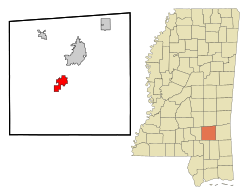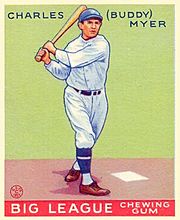Ellisville, Mississippi facts for kids
Quick facts for kids
Ellisville, Mississippi
|
||
|---|---|---|

Jones County courthouse in Ellisville
|
||
|
||

Location of Ellisville in Mississippi
|
||
| List of countries | United States | |
| State | Mississippi | |
| County | Jones | |
| Government | ||
| • Type | City | |
| Area | ||
| • Total | 10.55 sq mi (27.32 km2) | |
| • Land | 10.44 sq mi (27.04 km2) | |
| • Water | 0.11 sq mi (0.28 km2) | |
| Elevation | 253 ft (77 m) | |
| Population
(2020)
|
||
| • Total | 4,652 | |
| • Density | 445.59/sq mi (172.05/km2) | |
| Time zone | UTC-6 (Central (CST)) | |
| • Summer (DST) | UTC-5 (CDT) | |
| ZIP code |
39437
|
|
| Area code(s) | 601, 769 | |
| FIPS code | 28-22020 | |
| GNIS feature ID | 0669746 | |
Ellisville is a town in Mississippi, United States. It is one of the two main places where the government of Jones County operates. This means it's a "county seat."
In 2020, about 4,652 people lived in Ellisville. The town is also part of the larger area around the city of Laurel.
Contents
History of Ellisville
How Ellisville Got Its Name
The town of Ellisville is named after Powhatan Ellis. He was a U.S. Senator from Mississippi a long time ago. He was also known for being a descendant of Pocahontas, a famous Native American woman from Virginia.
Ellisville was chosen as the first county seat for Jones County. For many years in the 1800s, it was the biggest town and the main business center in the county.
Ellisville During the Civil War
During the American Civil War, Ellisville and Jones County were unique. Most people in the county were farmers who owned small farms and raised cattle. They did not own many enslaved people. In fact, in 1860, only 12% of the county's population was enslaved. This was the lowest percentage in all of Mississippi.
Many local men did not want to fight in the war to support slave owners. They were also worried about their own families. Their families needed them to help keep their small farms going. They also didn't like it when Confederate tax collectors took food and supplies their families needed to survive.
Because of these feelings, some Confederate soldiers left the army. They joined with enslaved people who had escaped. They formed a group called the Knight Company. Newton Knight led this group. They hid in a swamp near the Leaf River.
This group, with about 100 other Southern men, fought against tax collectors and Confederate army units. In 1864, they even took control of Ellisville. They took down the Confederate flag and put up the United States flag over the courthouse.
Ellisville and Laurel: A Tale of Two Towns
In the late 1800s and early 1900s, Ellisville became less important than nearby Laurel, Mississippi. Laurel grew into a big center for the timber (wood) industry and textile (fabric) factories.
Laurel's population became much larger than Ellisville's. Even though Laurel grew bigger, Ellisville still holds the main county government offices at the Jones County Courthouse.
The people living in Ellisville are mostly white. Laurel has more African American residents. This is because many farm workers moved to Laurel for jobs in factories and the city.
Geography of Ellisville
Ellisville is located at 31°36′4″N 89°12′8″W / 31.60111°N 89.20222°W. This means it's in the southern part of Mississippi.
The city covers a total area of about 5.6 square miles (14.5 square kilometers). Most of this area, about 5.5 square miles (14.2 square kilometers), is land. A small part, about 0.1 square miles (0.26 square kilometers), is water.
Population and People
Ellisville's Population Over Time
The number of people living in Ellisville has changed quite a bit over the years. Here's a look at how the population has grown and shrunk:
| Historical population | |||
|---|---|---|---|
| Census | Pop. | %± | |
| 1880 | 37 | — | |
| 1890 | 967 | 2,513.5% | |
| 1900 | 1,899 | 96.4% | |
| 1910 | 2,446 | 28.8% | |
| 1920 | 1,681 | −31.3% | |
| 1930 | 2,127 | 26.5% | |
| 1940 | 2,607 | 22.6% | |
| 1950 | 3,579 | 37.3% | |
| 1960 | 4,592 | 28.3% | |
| 1970 | 4,643 | 1.1% | |
| 1980 | 4,652 | 0.2% | |
| 1990 | 3,634 | −21.9% | |
| 2000 | 3,465 | −4.7% | |
| 2010 | 4,448 | 28.4% | |
| 2020 | 4,652 | 4.6% | |
| U.S. Decennial Census | |||
Who Lives in Ellisville Today?
The 2020 United States census counted 4,652 people living in Ellisville. There were 1,264 households and 810 families.
Here's a breakdown of the different racial groups in Ellisville as of 2020:
| Race | Num. | Perc. |
|---|---|---|
| White (non-Hispanic) | 2,502 | 53.78% |
| Black or African American (non-Hispanic) | 1,722 | 37.02% |
| Native American | 12 | 0.26% |
| Asian | 24 | 0.52% |
| Pacific Islander | 2 | 0.04% |
| Other/Mixed | 92 | 1.98% |
| Hispanic or Latino | 298 | 6.41% |
Education in Ellisville
Students in Ellisville attend schools run by the Jones County School District.
Ellisville is also home to Jones County Junior College. This college offers many different programs for students after high school.
Famous People from Ellisville
Many interesting people have connections to Ellisville:
- Lance Bass: A pop singer, famous for being a member of the group 'N Sync. He grew up in Ellisville.
- Harry Craft: A professional baseball player and manager. He was the first manager for the Houston Colt .45s team.
- Les DeVall: A former head coach for the McNeese State Cowboys football team.
- Redd Foxx: A well-known actor and comedian. He was raised by his grandmother in Ellisville during his younger years.
- Henry McCall: A former first baseman in the Negro league baseball.
- Chris McDaniel: A State Senator, attorney, and host of a radio show called The Right Side Radio Show.
- Buddy Myer: A two-time All-Star second baseman for the Washington Senators baseball team in the 1930s. He won batting and stolen base titles.
- Arnett Nelson: A talented jazz musician.
- Scottie Phillips: A former professional football player who played as a running back in the National Football League.
- Jeremiah Price: A professional football player in the National Arena League.
- Donnie Scoggin: A member of the Mississippi House of Representatives.
- Bobby Shows: A former member of the Mississippi House of Representatives.
- Jason Simpson: The head coach of the UT Martin Skyhawks football team.
- L. C. Ulmer: A musician known for playing delta blues music.
See also
 In Spanish: Ellisville (Misisipi) para niños
In Spanish: Ellisville (Misisipi) para niños





